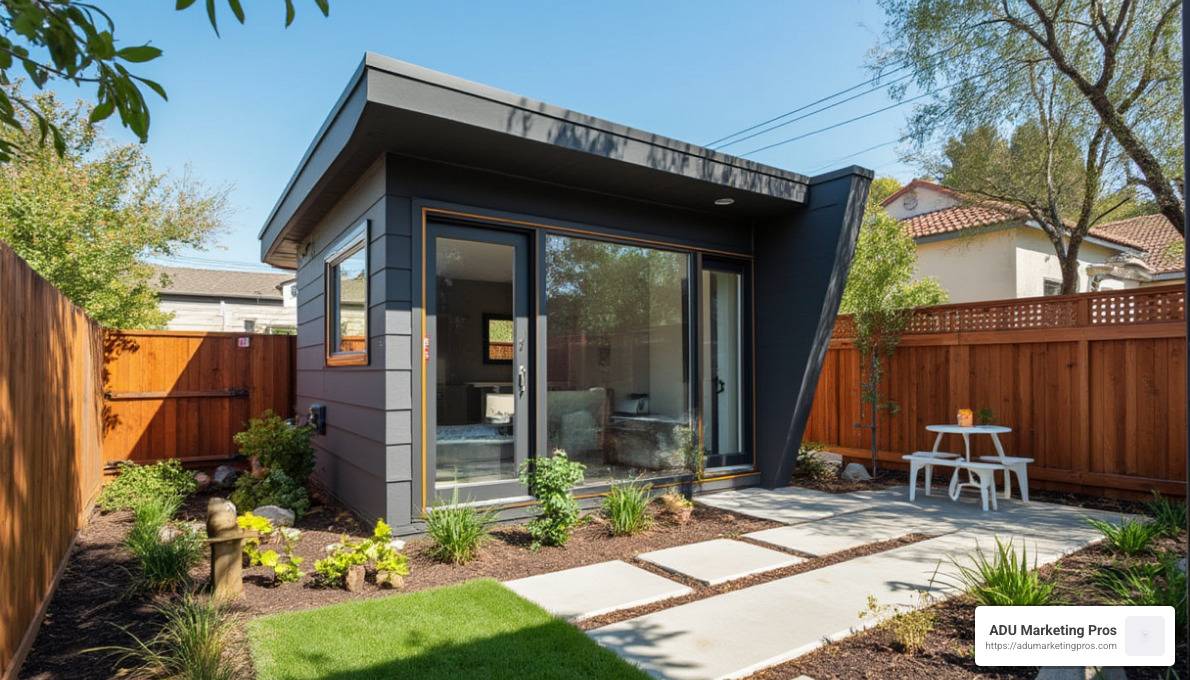In recent years, California has experienced an ADU boom that’s reshaping the landscape of residential housing. This surge in accessory dwelling units is not just a trend; it’s a revolution driven by evolving housing needs and supported by regulatory changes aimed at increasing housing density.
How big can an adu be in california? To address this question briefly:
- Detached ADUs: Can be as large as 1,200 square feet and require a minimum 4-foot setback from property lines.
- Attached ADUs: Generally must not exceed 50% of the square footage of the main house and have specific height restrictions.
- State Exemptions: Allow for at least 800 square feet ADUs, bypassing local restrictions on floor-area-ratio and setbacks for this size.
These updates to the ADU regulations are part of a broader movement to alleviate the California housing crisis, enabling homeowners to add functional living spaces within their properties. As David Garcia from the University of California at Berkeley notes, these legislative advancements essentially double the capacity of single-family zones, empowering homeowners and fostering diversity in housing options.
California’s regulatory framework, which initially emphasized single-family zoning, has been a significant barrier to housing development. However, with over 70% of land zoned for single-family homes, the potential for ADUs to provide much-needed housing solutions is significant. By simplifying the process, California is paving the way for urban densification, encouraging homeowners to contribute actively to housing availability.
The intersections of regulation, opportunity, and need make California’s ADU landscape an exciting field for innovation in living spaces. With the right approach, accessory dwelling units can become critical components of sustainable urban development in the state.

How Big Can an ADU Be in California?
When it comes to how big an ADU can be in California, the rules are clear but vary slightly depending on the type of ADU you’re considering—detached or attached. Let’s break it down.
Detached ADUs
Detached ADUs are standalone units that provide flexibility and privacy. In California, these can be up to 1,200 square feet in size. This generous limit allows homeowners to create spacious living areas that can serve as rental units, guest houses, or even home offices.
- Setbacks: Detached ADUs must have a minimum 4-foot setback from the rear and side property lines. This ensures that there is enough space between the unit and neighboring properties, maintaining privacy and safety.

Attached ADUs
Attached ADUs are connected to the main house, offering a seamless extension of the living space. The size of an attached ADU is generally limited to 50% of the square footage of the main house. This rule helps maintain the primary residence’s dominance and character.
- Height Restrictions: Attached ADUs must also adhere to specific height restrictions to ensure they blend well with the existing structure and neighborhood aesthetics. These restrictions can vary by local ordinances, so it’s crucial to check with the local planning department.
These size regulations for ADUs are part of California’s broader strategy to address the housing crisis by increasing residential density. By allowing these units to be built with fewer restrictions, California is encouraging innovation and diversity in housing solutions, making it easier for homeowners to contribute to the state’s housing availability.
Regional Variations in ADU Size
California’s ADU regulations set a broad framework, but local variations can significantly impact the size and design of ADUs. Let’s explore how Los Angeles, San Francisco, and San Diego differ in their approach.
Los Angeles
In Los Angeles, the rules for ADUs are relatively flexible, allowing for a maximum size of 1,200 square feet for detached units. This generous size limit means homeowners can build substantial living spaces, ideal for rental income or extended family living.
-
Two-Story ADUs: Los Angeles permits two-story ADUs, which is a unique allowance compared to many other regions. This option maximizes vertical space and can be a game-changer for smaller lots.
-
Zoning Laws: While the city allows for larger ADUs, zoning laws can influence where and how these units are built. It’s crucial to check local zoning ordinances to understand any additional restrictions or requirements.
San Francisco
San Francisco takes a more conservative approach, reflecting its dense urban environment. Here, the maximum size for a one-bedroom ADU is 850 square feet, while two-bedroom units can be up to 1,000 square feet.
-
Junior ADUs (JADUs): San Francisco also recognizes Junior ADUs, which are smaller units with a maximum size of 500 square feet. These are ideal for homeowners looking to add a compact, cost-effective unit.
-
Local Regulations: The city’s regulations are designed to maintain neighborhood character and manage density. As such, they are more restrictive, particularly in historic districts or areas with unique architectural styles.
San Diego
San Diego offers a welcoming environment for ADU development, with a maximum size of 1,200 square feet for detached units, similar to Los Angeles. However, there are specific limits based on the number of bedrooms.
-
Bedroom-Based Limits: San Diego’s regulations allow flexibility in ADU size depending on the number of bedrooms. For instance, a one-bedroom unit may have different size allowances compared to a two-bedroom unit, providing options custom to different needs.
-
Zoning Considerations: Like other cities, zoning plays a crucial role in determining where ADUs can be built. Homeowners should consult local zoning codes to ensure compliance and explore any potential incentives for building larger units.
These regional differences highlight the importance of understanding local regulations when planning an ADU. By aligning with city-specific guidelines, homeowners can optimize their ADU projects to meet both legal requirements and personal needs.
Maximizing Your ADU Space
Creating an ADU that feels spacious and functional, regardless of its size, requires smart design and clever use of space. Here are some strategies to make the most of your ADU.
Design Strategies
Open-Concept Layouts
Open-concept designs can make an ADU feel larger than it is. By minimizing walls and barriers, you create a seamless flow between spaces like the kitchen, living room, and dining area. This approach not only improves movement but also allows for more flexible use of space.
Natural Light
Natural light is a powerful tool in making spaces feel open and inviting. Large windows, skylights, or even glass doors can flood your ADU with light, creating a bright and airy atmosphere. Strategically placed windows can also offer views and ventilation, enhancing the overall comfort of the space.

Storage Solutions
Built-In Cabinets
Maximize your ADU’s storage without sacrificing space by incorporating built-in cabinets. These can be custom to fit snugly into available nooks and crannies, providing ample storage without intruding into the living area. Consider built-in shelving units or under-stair storage for added efficiency.
Vertical Space
Don’t overlook vertical space. Tall storage solutions, like floor-to-ceiling shelves or high-mounted cabinets, use the full height of the room. This not only increases storage capacity but also draws the eye upward, creating the illusion of a larger space.
Multi-Functional Furniture
Opt for furniture that serves multiple purposes. A sofa bed, for example, can transform your living room into a guest bedroom. Similarly, a dining table with built-in storage or a coffee table that doubles as a desk can help you make the most of limited space.
By implementing these design and storage strategies, you can create an ADU that feels both spacious and functional, regardless of its size. These approaches ensure that every square foot is optimized, providing comfort and convenience for its occupants.
Frequently Asked Questions about ADU Sizes
Can an ADU be larger than the primary residence?
In California, an ADU cannot be larger than the primary residence. For attached ADUs, the rule is clear: they must not exceed 50% of the square footage of the main house. Detached ADUs have a bit more flexibility but are capped at 800 square feet if they surpass the main residence in size. This ensures that the ADU remains secondary in size and function to the primary dwelling.
What is the minimum size for an ADU in California?
The minimum size for an ADU in California is 220 square feet. This baseline ensures that even the smallest ADUs provide adequate living space for residents. While this is a state guideline, local jurisdictions may have additional requirements or recommendations, so always check with your local planning department.
Can you build a 2-story ADU in California?
Yes, you can build a 2-story ADU in California, but local regulations will dictate the specifics. In some areas like Los Angeles, 2-story ADUs are permitted, offering more flexibility in design and space utilization. However, height restrictions are a key consideration, generally capped at 16 feet unless local zoning laws allow for exceptions. Always verify with your local authorities to ensure compliance with height and design standards.
Conclusion
Navigating the complex landscape of ADU size guidelines in California can be daunting. With varying regulations across cities like Los Angeles, San Francisco, and San Diego, it’s crucial to have expert guidance. This is where ADU Marketing Pros steps in to assist ADU construction and architecture firms in making informed decisions.
Our expertise in the ADU market ensures that your firm not only meets regulatory standards but also stands out in a competitive environment. By focusing on custom marketing strategies, we help you attract high-quality leads and grow your revenue. Our approach is built on understanding the nuances of local regulations, such as the 1,200 square foot limit for detached ADUs and the specific height restrictions for attached units.
Our market insights are rooted in continuous research and a deep understanding of consumer behavior. We leverage this knowledge to craft targeted marketing solutions that highlight your expertise and differentiate your services from generic offerings. With our support, your firm can confidently steer the evolving ADU landscape and capitalize on the growing demand for these versatile living spaces.
For more information on how we can help your business thrive in the ADU sector, visit our services page. Let us be your trusted partner in achieving success in the dynamic world of ADU construction.




